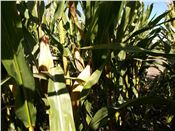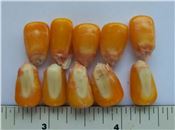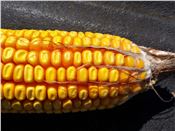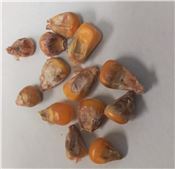Why Are The Corn And Soybean Crops Drying So Slowly?
DR. EMERSON NAFZIGER
URBANA, ILLINOIS
As corn approached maturity in early September, warm temperatures and forecasts for dry weather had us looking forward to an early start to harvest for the 2022 corn crop, and a slightly delayed but rapid movement towards getting soybeans harvested as well. Instead, both crops have languished, with corn only 63 percent mature and 13 percent harvested, and only 10 percent of the soybean crop harvested by October 2.
The first thing that comes to mind as an explanation for the slow drying is the cool weather in recent weeks. It has in fact been cooler than normal, but only for the last two weeks or so. For the first three weeks of September, daily the high temperature at Champaign averaged 82 degrees, low temperature averaged 58, and 423 growing degree days accumulated. That’s about 50 GDD more than normal for that period, and only about 70 GDD less than the normal for the whole month. Only 91 GDDs accumulated over the last nine days of September, but the monthly total was close to normal in Illinois.
Cloudy, rainy weather as the crops are approaching maturity can slow the drying process. September, though, was not a wet month: rainfall for the month was below normal in nearly all of Illinois. At Champaign, it rained about an inch less than normal (normal is 3.35 inches.) More than half the monthly total (1.22 out of 2.26 inches) fell on September 19, and of the eight days with recorded rainfall, three recorded only 0.01 inch.
The 2022 Illinois corn and soybean crops were not planted early: the 50 percent planted date was May 14 for corn, about two weeks later than normal, and May 19 for soybean, which is close to normal. The summer was slightly warmer than normal, so by the end of August, crop development was only a little behind normal. Based on GDD accumulations, most of the corn crop should have reached black layer by September 15. Soybean flowered later than normal, and most fields showed little loss of leaf color by mid-September.
Why have corn and soybean crops been so slow to reach harvestable moisture? I believe that the pattern of dry weather in 2022 set the stage for this. In corn, kernel numbers were reduced by stress in dry areas, with a lot of ears setting normal row numbers but only 20 to 30 kernels per row, and only 300 to 450 kernels per ear. Leaf health remained good, however, and canopy color remained fairly good even in dry areas. Once drought was partly alleviated by rainfall in July and again in early August, the crop took up nitrogen along with water, and ended up having more capacity to fill kernels than it had kernels to fill. The general concern that the drought conditions would produce smaller kernels simply didn’t materialize.
Corn
What happens when corn plants have good capacity to fill kernels, but the number of kernels is lower than normal? A few observations:
Plant leaves can stay green much longer than normal. Maturity usually arrives as green color fades, but this year, some corn has been harvested as (high-moisture) grain while leaves were still dark green.
We planted a 114-day hybrid on May 17 near Champaign, and it has good color still in early October (Figure 1). This crop had accumulated a little more than 3,000 GDDs from planting to the time we harvested some ears on October 3. Company says that this hybrid requires 2,875 GDD to black layer, so it should have been fully mature on this date.
We’ll discuss in a later article how having green plants at maturity affects nitrogen nutrition.
Kernels may not reach true “black layer” as they normally do at maturity. Green leaves on plants with grain at or past normal maturity is a signal that sugars have built up in the plant, including in the cob. Green leaves continue to photosynthesize, but with no part of the plant still growing, these sugars have no place to go. The cell layer at the tip of the kernel that normally dies and darkens when the flow of sugar into the kernel stops has no signal to do that, and so stays alive. This does not mean that sugars are still moving into the kernels: at the point when the kernels can’t accommodate any more sugar (to convert to starch), sugar accumulates and doesn’t move.
Such kernels are in fact mature – they can add no more dry weight – but the black layer may not show up very well until the leaves are dry and the sugar supply is cut off. Drydown will be slow until that happens, and it may take freezing to kill the leaves and to get the process to speed up. Besides maintaining the sugar supply, green leaves also limit air movement within the canopy, which also slows drying.
When the plant’s capacity to fill grain exceeds what the (lower) number of kernels can accommodate, kernel size gets larger than usual in many fields. Figure 2 below shows a closeup of kernels harvested from plants like those shown in Figure 1. The grain sample from these had kernel moisture of 31.5 percent, which is within the normal range of moisture for grain at maturity, but is higher than it would be if leaves had dried as the crop matured. A sample of kernels, with weight adjusted to standard moisture, showed that these kernels weighed almost a pound per thousand, which converts to about 58,000 kernels per bushel. That’s very high for kernel weight. Not all fields will have such high kernel weights, but we can expect actual yields in many cases to be higher than those estimated by converting early kernel counts to bushels per acre using a factor of 80,000 or 85,000 kernels per bushel. As an added note, the test weight for this sample was 53.9 lb per bushel, before correction for high moisture. It should be 57 or 58 once the grain dries down. The abundance of sugars and the tight packing of starch in the kernels should mean good test weights in the 2022 crop. Deep kernels also mean that water has farther to move as the grain dries, which slows the process.
One less positive development this fall is the widely-reported occurrence of ear mold in a crop that otherwise looks healthy.
September began with warm, dry weather that we expected to cause husks to loosen quickly, to allow grain to dry down fast. Instead, as is visible in Figure 1, a lot of husks remain tightly attached into October. Many ears have stayed upright as well, perhaps due to good shank development, and also because ears aren’t as heavy as they would be with more kernels. Figure 3 below shows an ear (of a different hybrid than the one shown above) that shows fungal growth on the silks and on some kernels at the end of the ear. While this amount of mold doesn’t look threatening, some ears like this have more kernel mold than they appear to have. Figure 4 shows kernels from an ear that looked similar to the one in Figure 3, but shelling it revealed several dozen moldy kernels. One unusual aspect of this is that the crown of a kernel might look normal, but the rest of the kernel is shrunken and moldy. The standard practice of setting the combine to blow these kernels out during harvest may not work as well when part of the kernel has normal density.
We can be sure that the 2022 corn crop will eventually dry down so that harvest can speed up. Early opportunities to deliver corn with low (or no) drying charges have mostly expired, so it’s back to normal drying charges, which may be high enough to keep the crop drying in the field for a while longer. Most fields are standing well, but ear molds will continue to develop and spread as long as the grain moisture remains elevated, especially if the husks remain tight. The bonus for all this is the high yields that many fields will produce, even in areas that were dry most of the summer. This ability of the corn crop to maintain its potential to come back from periods of unfavorable conditions is a modern marvel.
Soybeans
The story of soybean this season is a little less dramatic than for corn, but is noteworthy for high yields that follow drought stress.
The expectation that stress would lower pod numbers didn’t materialize: once leaves dropped and pods became visible, the potential for high yields was obvious. Early indications are that soybean yields are high. Soybean flowering and podsetting were delayed this year, and leaf color loss and leaf drop were delayed as well, with only early- maturing varieties harvestable much before the end of September. The plants were able to make good use of the warm weather during the first half of September, but the progress toward maturity and drydown has been slowed by the cool temperatures of the past two weeks.
The soybean crop canopy was excellent in most fields in August, at least once soil moisture supplies were renewed by rainfall in the drier areas. Plants added pods up to about the second week of August, a little later than normal. Moisture also helped restore plant height in most fields, although the upper part of the stem is a little spindly, with low pod density, in some fields.
One issue that has come up with soybeans in some fields is having stems stay green after pods have dried down. This probably doesn’t quite meet the definition of green-stem that we see when pod numbers are very low, but it has the same cause: sugars and water remain in the stems after seeds have stopped taking in sugars, and without leaves to help move water, stems dry out slowly. This is often more pronounced in later-maturing varieties and in fields that have been sprayed with fungicide. It will take some time and drying weather to get stems to dry down, and grain could very well drop to 10% moisture or less as we wait for that to happen.
Wheat?
This is not on the slow-drying topic, but I have seen a few fields in central Illinois that look like they’re being made ready to plant wheat this fall. This has been encouraged both by the price of wheat and by the prospect of being able to doublecrop soybeans after wheat harvest next summer. Genetic improvements in soybean should help the soybean crop even when it gets planted late, but we have mostly anecdotes instead of planned research to suggest how well double-crop soybeans will do in central Illinois. Expecting doublecrop yields to be about 2/3rds of full-season yields is reasonable for planning purposes.
The end of September and early October are timely for planting wheat in central Illinois. Planting earlier doesn’t move wheat harvest a lot earlier, but it can sometimes move doublecrop planting up by a few days. Early-maturing winter wheat varieties can be harvested a little earlier, but they sometimes pay a price by breaking dormancy earlier in the spring, which can subject them to freeze damage.
Wheat works best when drilled at seeding rates of around 30 per square foot (1.3 million per acre). Soil test P should be adequate, and some N is usually applied in the fall, with the largest amount applied in the spring. seed can be broadcast or planted in 15-inch rows, but drilling is a more sure way to get uniform stands. ∆
DR. EMERSON NAFZIGER: Research Education Center Coordinator, Professor, University of Illinois

Photo of a 114-day hybrid planted on May 17, 2022, with photo taken on October 3.

A closeup of kernels harvested from the field with plants shown in Figure 1.

Ear showing fungal growth, probably Gibberella or Fusarium.

Moldy kernels from the tip of an ear like the one shown in Figure 3.